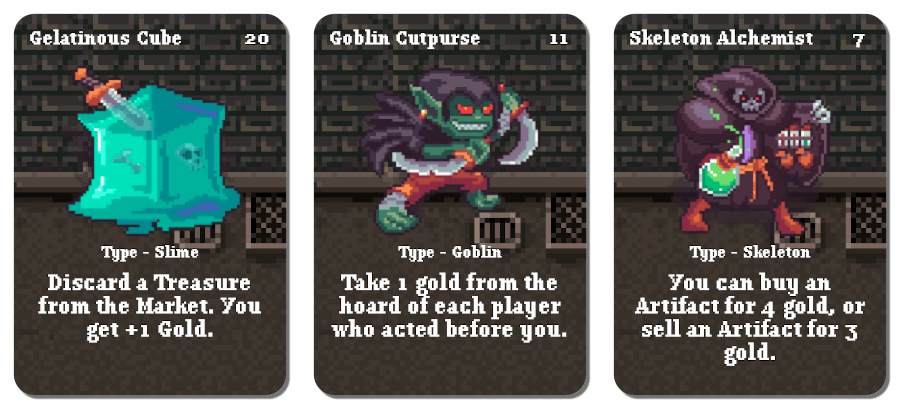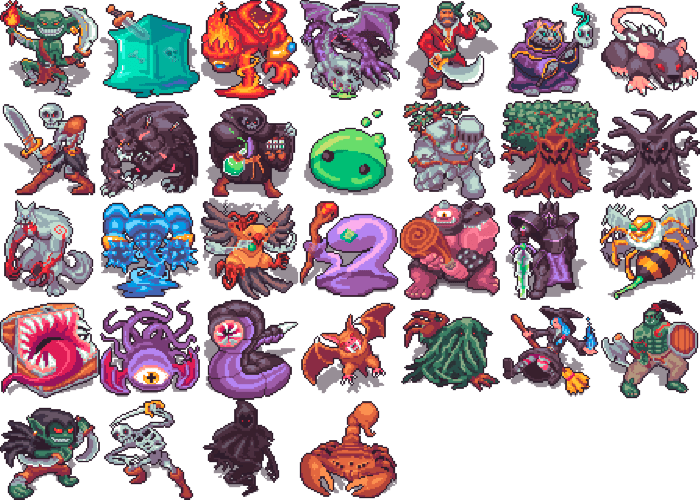Every month of 2022, I am trying, as part of both my PhD project and my all-purpose general game development, develop if not a whole game for game development, a project start, such that I can make playtest prototypes. This is a sort of report of the process throughout the month.
It says a lot about the design this month that I’m looking at my mocked up preview cards from late in the month and quietly being annoyed that it’s going to take me a while to get a test print of this game delivered to my house to play around with it.

Week 1
It’s Friday of the first week of May and ah…
I haven’t started yet? I did a brainstorm post but my main feeling reacting to that is hey, I’m not feeling that. That’s interesting to me, that’s really wild, because I’m normally a festival of thoughts on this matter.
I did notice I was looking at a lot of Videogame material. Videogame assets are, perhaps obviously, a bit thicker on the ground, and thanks to the comparable ease of creation, pixel art versions are more available. Thing is, I don’t like just painting on videogame aesthetics onto a game – I want the game to evoke the feeling of a videogame.
I dedicated some time, then, to thinking about what a videogame mechanic that tabletop games could replicate in a way that was interesting… and that put me in the vein of action selection games. More on that later I think.
Week 2
I’m thinking about action selection games. I’m looking at Libertalia specifically. Libertalia relies on a board and decks of cards and tokens and counters, which is all Gamecrafter-level doable. The original Libertalia is extremely out of print and therefore, extremely expensive if you want a copy. It’s an action selection game, where you have a deck of cards representing different crew members on your pirate ship, moving along a track and acting in order.
Problem: Action selection games are often limited in the number of actions you have.
Solution: Lots of actions.
New problem: Players are overwhelmed by their actions.
Solution: Limit them to a hand.
New new problem: Now you don’t know what actions your opponents may play.
Recently, we got Libertalia: Winds of Galecrest. This solves this by having a deck of actions (‘crew’), but where the first player draws a hand of random cards from the deck, reveals them to other players, and they draw the same hand. Now the action selection is based on the same six cards for the round.
That then gets to complicate further: each round, players get to keep some cards from the previous hand then the new one gets drawn. So the complication escalates, but it does so slowly. It’s an interesting engine. I haven’t played Libertalia: Winds of Galecrest, so I can’t say for sure how good an idea it is to build off this. I don’t know what that game uses this engine for, but it’s a place to start.
Week 3
With the Libertalia idea, there’s a similar thing in Magic: The Gathering conspiracy set. Cards that do more the later you’re willing to do them, but knowing you can run the risk of losing your opportunity. I’m liking the Winds of Galecrest idea too.
That’s another fun math one, too. We have some factors in how the game can develop:
- Each player needs an identical deck
- The deck needs to divide into a number of rounds cleanly
Let’s say hypothetically, the starting hand is six, you carry over two each round, and I want five rounds. That’s 6 in the first hand, then 4 for the second, 4 for the next, 4 for the next, and 4 for the last – so 22 cards. Assuming a maximum of five players, that’s a deck of 110 cards.
In that case, a game will feature every card. If we add two more so that there will be two burn cards, the deck would be 120 cards. Then there’s board and token and counters and then the question becomes what is this game trying to do?
Upon review… I actually realise that Libertalia: Winds of Galecrest does this already. Like, the decks are all the same. So… I just spent a week recreating the wheel.
Week 4
Alright, so I sat down and decided I had two basic ideas: It’s either a treehouse full of your allies going out to do quests for you and come back, or it’s a dungeon you’re defending.
To be entirely, 100% honest, I decided to go with a dungeon design, because I think that if I make the hero friend game, with the same engine, but more complex, Fox would want to be involved. Okay, so I’m going dungeon maker.
The game play loop now:
- The starting player shuffles their deck, and draws up to six cards. They show the six cards they have, and the other players get those cards out of their deck. Now you have six cards in your hand.
- On your turn, pick a card from your hand, play it face down, then players reveal them simultaneous. The cards do what they do based on the number on them in order.
- Repeat until you have four cards, that represent the four monsters defending that layer of your dungeon, in the order they were shown
- Flip a hero from the hero deck, and see which dungeon it goes to.
- The loop then repeats: Each player draws up to six cards and the gameplay loop repeats. This means that each player has two cards from their first hand in the next hand.
What I need is dials. I need ways for there to be 20ish discrete game actions that can be meaningfully different to one another. Especially when they can scale up based on their position in the priority chain. The simplest version of the game is that every single tile gives you +1 point, and the question then just becomes how many of those cards you can play in sequence. But that’s very bland and flavourless.
What’s more we have a potential problem with ties. If I have a 6 and you have a 6 and the 6 says to do a thing, do we both do it? If we do, do we do it at the same time? If we don’t, how do we determine who does it? Do we cancel each other out?
Hard to call.
Now, while I was ruminating on this I found this wonderful asset pack.

I like this because a lot of the art has a permutation. The goblin has a more dangerous goblin, the tree has a dead tree, the slime can be seen in three different forms – a baby, a cube and a slime wizard. This means that some cards can be more complex versions of simpler, workhorse cards.
I thought about giving heroes a bunch of ideas, like giving them a strength that they could punch through, but I think that complicates the game and makes resolving heroes slower. So the heroes will raid a dungeon that suits them best, and they just ‘get to’ and impose problems. You hold onto a hero card, like, that’s the story of ‘oh yeah you got screwed.’
To add some counterplay to that, hero cards are going to need potential responses… and that gives me a new slot. Like, let’s say we have a priest hero. If you get beat up by a priest, you can heal the harm with a Dark Altar. If you have a Dark Altar, a priest may not be able to defeat your dungeon.
I also want a basic contingency, a way that players who want to just protect themselves from heroes in general can do something prophylactic.
I figure there should be a basic scoring mechanism, which is gold. Like, monsters like their GPs.
Finally, I want to resolve that potential ties problem.
This gives me the following list of categories of game action:
- Give you gold.
- Give you access to these hero responses.
- The prophylactic hero counter.
- Gain a property that wins ties.
Let’s flavour some of these things up:
- Add to your Hoard (+Gold)
- Claim an Artifact (hero responses)
- Build Dread (Prophylactic hero counter)
- Seize the Initiative
Initiative is simple; the player with initiative wins ties. If you don’t have initiative and you’re in a tie, you lose. If you do have the initiative, and you’re in a tie, you win. Easy.
Dread is the fear and reputation of your dungeon. The player with the highest dread simply scares off heroes.
Artifacts are cards. Deal ’em out, and then now we have a thing for players to fight over. Each round deal out some artifacts, and add to the pile. We don’t need a lot – they can be as simple as a 1:1 comparison with the heroes’ abilities.
Hoard is the gold you have. Winner at the end has the highest score, and gold probably makes a bunch of that.
And with that… I now have all the pieces my game system wants to interact with. Like, from here, it’s just a simple process of making a list of mechanics for each card. The game system should sort every other part of it out. I think I want seizing the Initiative to be rarer than artifacts, and I want dread to be rarer than gold, so generally, it might be that of my 20 card pool to start, we have say… 7 gold cards, 6 dread cards, 4 get-an-artifact cards, and 3 Initiative cards.
Then the heroes and the artifacts are just a matching set – ten heroes, ten artifacts, and maybe some other artifacts for cutesy bits. The artifacts have to have a value at the end of the game too – they’re worth gold, or something like that – so that players have a reason to want them that isn’t just depriving an opponent.
In Summary
I’m not going to lie about this one: A lot of the work on this one was done in literally the last few days. I planned to do it more leading up, but a surprising amount of the work in making the game was just trying to find art assets I could use. I mean, I didn’t need to, but art assets give me, I find, something I can anchor an identity to.
This game looks to me like it’s going to be fun; the simplest form of it is going to have some very boring Artifacts and very boring Heroes to start with, but that, I think, will come out in playtesting to determine what works about it.